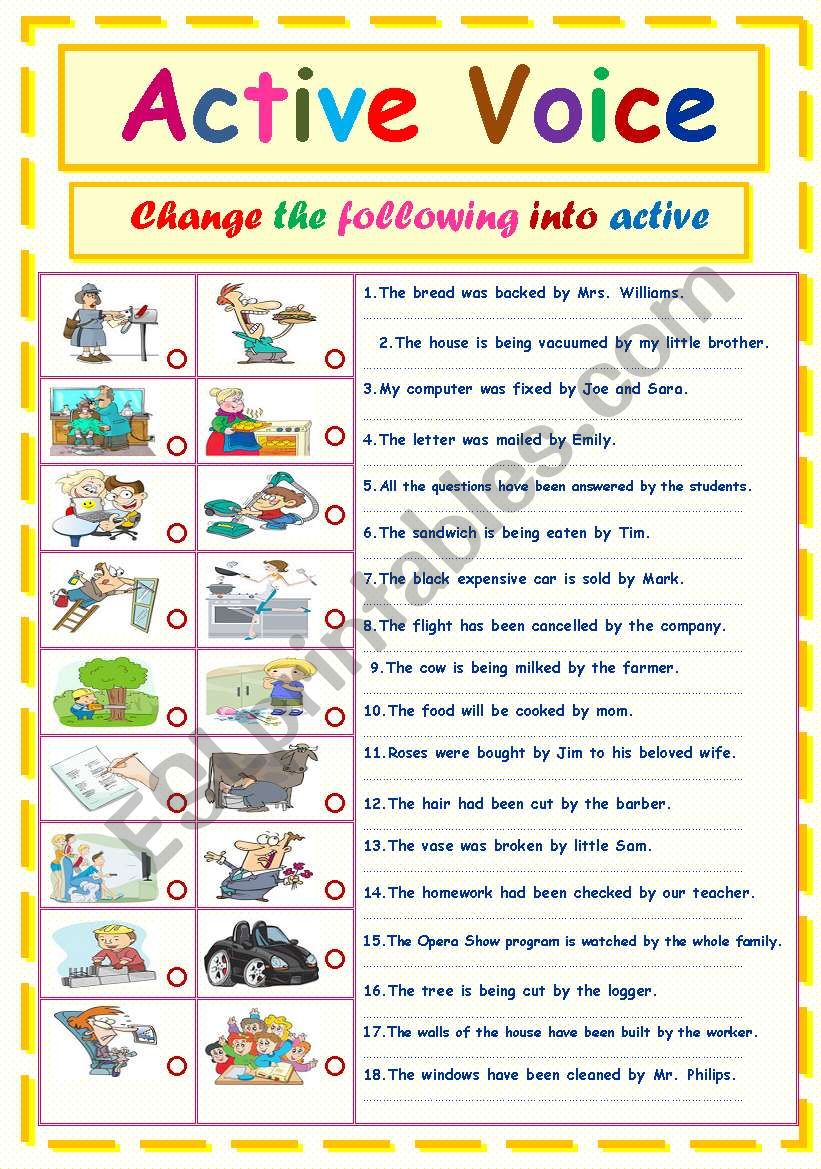
Mastering Clarity and Impact: The Indispensable Role of Active Voice Worksheets
In the vast landscape of English grammar, few concepts wield as much power over the clarity and impact of writing as the active voice. It is the bedrock of strong, direct, and engaging communication, making sentences vibrant and easy to understand. Conversely, the passive voice, while having its specific uses, often leads to convoluted, impersonal, and sometimes vague prose. For learners and seasoned writers alike, grasping the nuances of the active voice is crucial, and one of the most effective pedagogical tools for achieving this mastery is the strategic use of active voice worksheets.
This comprehensive article will delve into the profound importance of the active voice, explore why worksheets are an unparalleled method for its instruction and reinforcement, detail various types of active voice worksheets, discuss their design principles, and highlight the myriad benefits they offer to both learners and educators.
The Power of the Active Voice: Why It Matters

At its core, the active voice is straightforward: the subject of the sentence performs the action. For instance, in "John hit the ball," John (the subject) performs the action of hitting. In contrast, the passive voice often places the receiver of the action as the subject, with the doer either implied or stated in a "by" phrase: "The ball was hit by John," or simply, "The ball was hit."
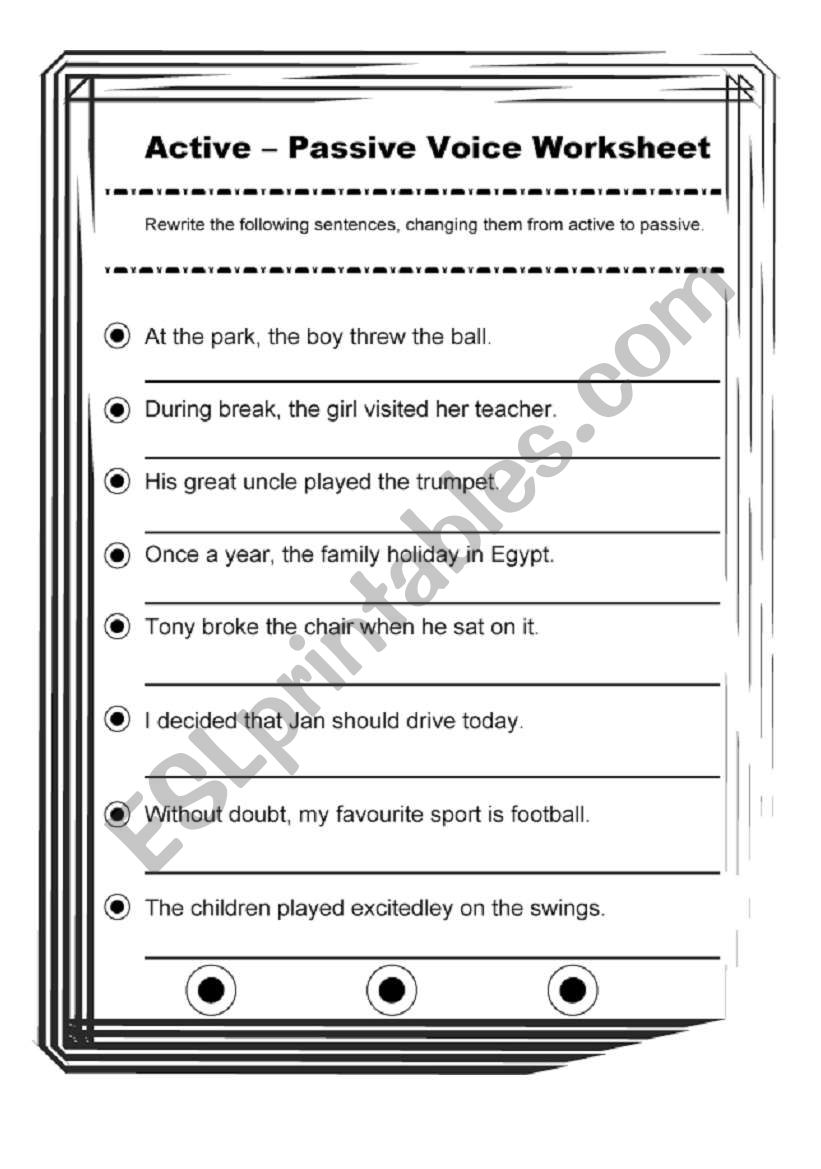
The preference for active voice in most writing contexts stems from several key advantages:
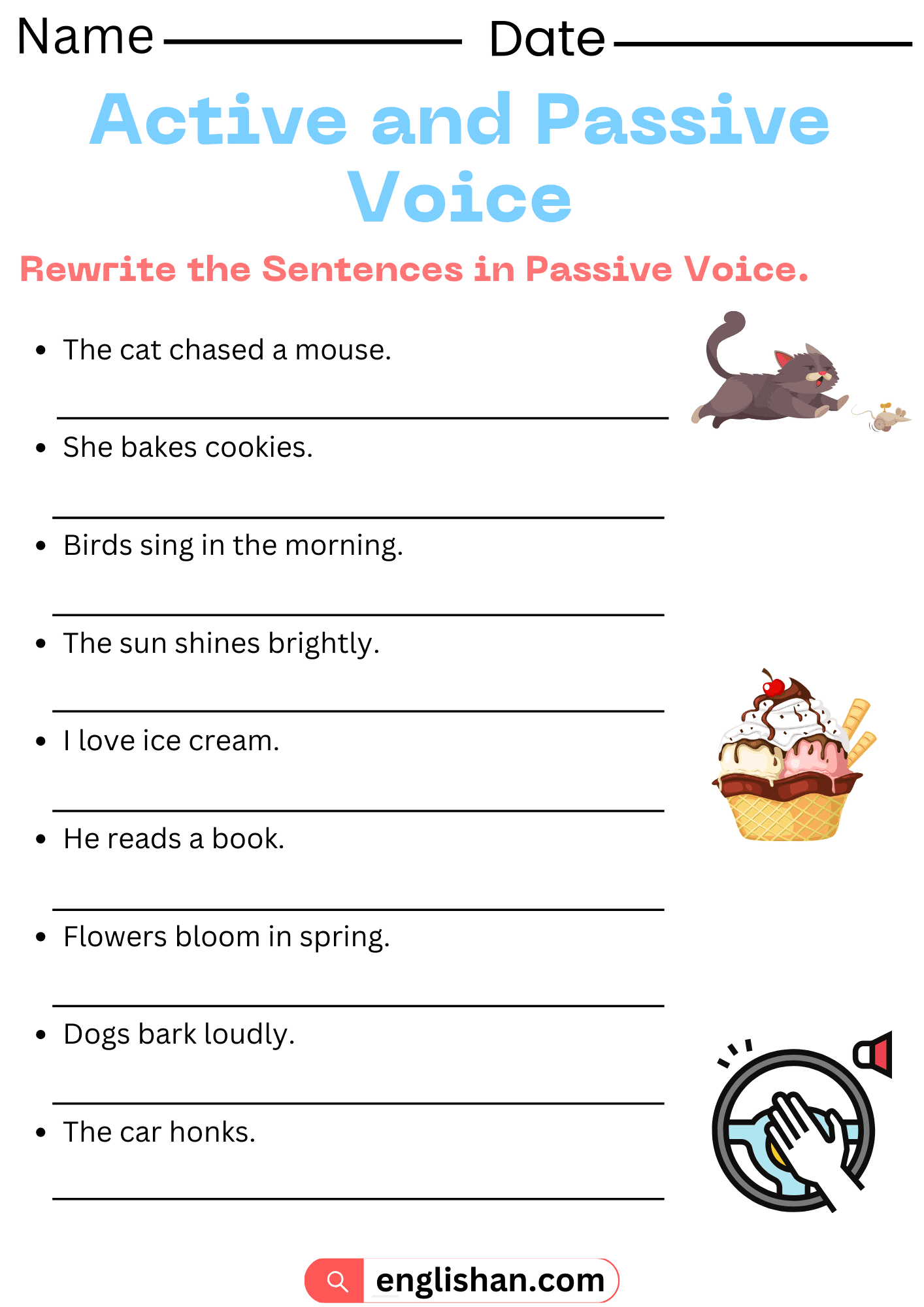
- Clarity and Directness: Active voice immediately tells the reader who is doing what. This directness eliminates ambiguity and makes sentences easier to process. In the passive voice, the doer of the action might be omitted, leaving the reader to wonder.
- Conciseness: Active voice sentences are typically shorter and more economical with words. Eliminating auxiliary verbs and "by" phrases reduces wordiness, making writing more impactful.
- Impact and Strength: Active voice conveys a sense of agency and responsibility. It makes writing sound more authoritative and dynamic, crucial for academic papers, business reports, and persuasive essays.
- Engagement: When the subject is actively performing an action, the sentence feels more alive and engaging. Passive constructions can sound detached and monotonous.
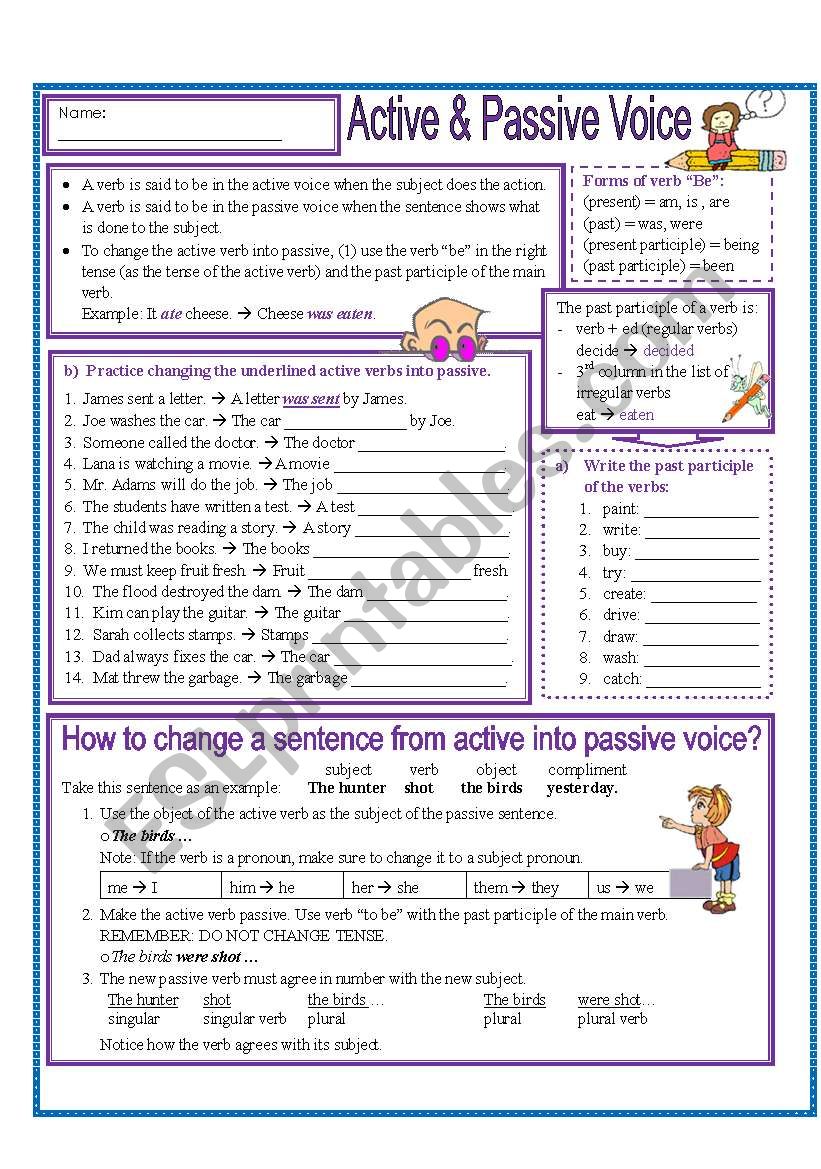
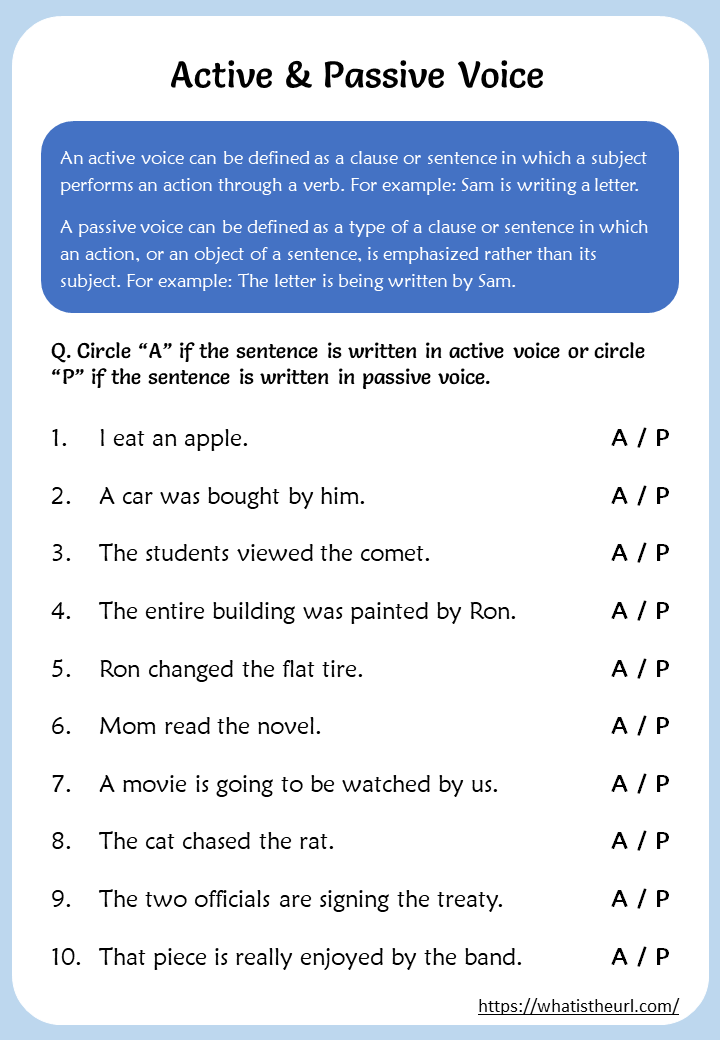
While the passive voice has legitimate uses (e.g., when the doer is unknown or unimportant, or to create an objective tone in scientific writing), its overuse is a common pitfall that active voice training aims to correct.

The Indispensable Role of Worksheets in Grammar Instruction
In an era of dynamic digital learning, the humble worksheet might seem antiquated, yet its value in grammar instruction, particularly for concepts like active voice, remains unparalleled. Worksheets provide a structured, hands-on approach to learning that complements lectures, discussions, and digital resources. They bridge the gap between theoretical understanding and practical application.
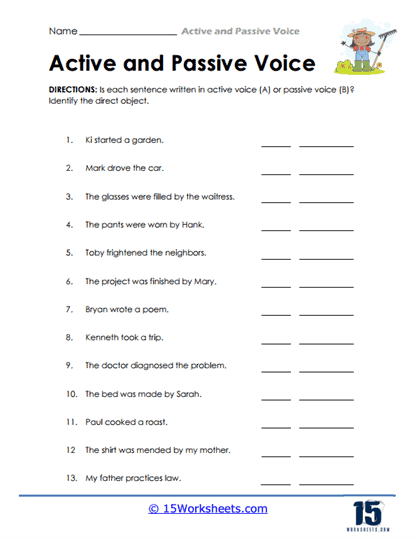
Here’s why active voice worksheets are so effective:
- Structured Practice: They offer a systematic way to practice identifying, transforming, and constructing sentences in the active voice. This structured repetition helps solidify understanding.
- Immediate Application: Learners can immediately apply what they’ve learned, reinforcing concepts as they go.
- Self-Assessment: Many worksheets come with answer keys, allowing learners to check their work independently and identify areas where they need more practice.
- Targeted Feedback: For educators, worksheets provide a clear snapshot of a student’s comprehension, enabling targeted feedback and individualized instruction.
- Reinforcement: Consistent practice through worksheets helps move the conscious application of active voice into an intuitive, unconscious habit.


Types of Active Voice Worksheets: A Comprehensive Toolkit
Effective teaching requires a variety of approaches, and active voice worksheets can be designed to target different learning objectives and skill levels. Here are some common and highly effective types:
-
Identification Worksheets:
- Objective: To help learners distinguish between active and passive voice.
- Activities: Students read sentences and identify whether they are in active or passive voice (e.g., by circling, underlining, or marking ‘A’ or ‘P’). Some might ask students to highlight the subject and the verb to confirm their choice.
- Example: "The book was read by many students." (Passive) vs. "Many students read the book." (Active)
-
Transformation Worksheets (Passive to Active):
- Objective: To enable learners to convert passive voice sentences into active voice. This is arguably the most critical skill.
- Activities: Students are given a list of passive sentences and tasked with rewriting them in the active voice. This often requires identifying the implied or stated "doer" of the action.
- Example: "The decision was made by the committee." (Passive) → "The committee made the decision." (Active)
- Variations: Some might include sentences where the doer is not explicitly stated in the passive voice, challenging students to invent a logical subject (e.g., "Mistakes were made." → "I/We made mistakes.").
-
Sentence Construction Worksheets:
- Objective: To encourage learners to generate original sentences using the active voice.
- Activities:
- Prompt-based: Students write active voice sentences based on given subjects, verbs, or scenarios.
- Image-based: Students describe actions depicted in pictures using active voice.
- Topic-based: Students write sentences about a specific theme (e.g., "Describe your daily routine using active voice.")
-
Error Correction Worksheets:
- Objective: To help learners identify and correct instances of inappropriate passive voice use.
- Activities: Students are given paragraphs or short passages containing misused passive voice and are asked to rewrite them for clarity and impact using active voice. This moves beyond isolated sentences into contextual application.
-
Contextual Application Worksheets (Paragraph/Essay Revision):
- Objective: To apply active voice principles in longer pieces of writing.
- Activities: Students review their own writing samples (or provided samples) and identify areas where converting passive voice to active voice would improve clarity, conciseness, or impact. This is often an advanced stage, integrating grammar into the broader writing process.
Designing Effective Active Voice Worksheets
The effectiveness of any worksheet hinges on its design. For active voice worksheets, several principles ensure maximum learning utility:
- Clear and Concise Instructions: Students should understand exactly what is expected of them without ambiguity.
- Gradual Difficulty: Start with simpler identification tasks and progressively move to more complex transformations and contextual applications. This scaffolding prevents overwhelm and builds confidence.
- Varied Exercise Formats: Mix and match exercise types within a single worksheet or across a series to maintain engagement and cater to different learning styles.
- Relevant Content: Use sentences and scenarios that are relatable or interesting to the target audience. This makes the practice feel less abstract.
- Sufficient Practice: Provide enough exercises for the concept to sink in, but not so many that students become bored or fatigued.
- Inclusion of Answer Keys: Essential for self-correction and immediate feedback, especially for independent study or homework.
- Space for Responses: Ensure ample space for students to write their answers clearly.
Benefits of Active Voice Worksheets for Learners
For students, consistent engagement with active voice worksheets yields significant improvements:
- Enhanced Writing Clarity: They learn to write sentences that are direct and easy to understand.
- Increased Conciseness: Students develop the skill of eliminating unnecessary words, leading to more impactful prose.
- Improved Critical Thinking: The process of identifying the "doer" and "receiver" of an action sharpens analytical skills.
- Greater Confidence in Writing: As they master this fundamental aspect of grammar, students become more assured in their ability to communicate effectively.
- Better Communication Skills: The principles learned extend beyond writing into speaking, leading to more assertive and clear verbal communication.
Benefits of Active Voice Worksheets for Educators
Educators also reap substantial rewards from incorporating active voice worksheets into their curriculum:
- Efficient Assessment: Worksheets provide a quick and clear way to gauge student understanding of active voice.
- Differentiated Instruction: It’s easy to create or select worksheets of varying difficulty levels to cater to diverse learning needs within a classroom.
- Resource Creation: Well-designed worksheets become reusable resources that can be adapted for different groups or over successive academic years.
- Time-Saving: Ready-made or easily adaptable worksheets reduce preparation time, allowing educators to focus on individualized feedback and deeper instruction.
- Structured Lesson Planning: Worksheets can form the core of a lesson, guiding students through the learning process systematically.
Integrating Active Voice Worksheets into Learning Environments
Worksheets are versatile and can be used in various educational settings:
- In the Classroom: As warm-up activities, in-class practice, group work, or as part of a larger lesson plan on sentence structure or style.
- As Homework: To reinforce concepts learned in class and provide additional practice.
- For Self-Study: Ideal for independent learners who want to improve their writing skills at their own pace.
- In Online Learning Platforms: Digital versions of worksheets can be integrated into learning management systems, often with auto-grading features for instant feedback.
Conclusion
The active voice is a cornerstone of effective English communication, empowering writers to be clear, concise, and impactful. While the concept itself might seem simple, mastering its consistent application requires deliberate practice. This is precisely where active voice worksheets prove their invaluable worth. They offer a structured, practical, and effective means for learners to identify, transform, and generate active voice sentences, moving from theoretical understanding to ingrained habit.
By embracing diverse types of worksheets, adhering to sound design principles, and integrating them thoughtfully into learning environments, educators can equip students with a powerful tool for enhancing their writing clarity and overall communicative prowess. In an age where effective communication is paramount, the role of active voice worksheets in shaping confident and articulate writers cannot be overstated.
